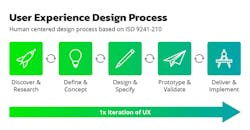What you'll learn:
- The ramp up of sophistication within IVI systems.
- Using the Android Automotive OS to create an full IVI ecosystem.
The global market for in-vehicle infotainment (IVI) systems is large and growing, driven by consumers’ demand for smartphone-like functionality in their cars. According to recent research by MarketStudyReport, the worldwide market for automotive infotainment systems is expected to grow from $25 billion in 2020 to $42.85 billion by 2027, a growth rate of 8% per year.1
This obviously creates a huge revenue opportunity for automotive manufacturers. Consumers continue to seek more in-vehicle entertainment options, real-time communication, robust connectivity, enhanced safety, greater comfort, and ease of navigation. In turn, the world’s leading automakers are racing to develop advanced systems that meet these needs and are constantly brought up-to-date with the latest developments happening in consumer electronics, especially smartphones.
By offering the most innovative, advanced infotainment systems, car companies can not only win the short-term sale, but reinforce their brand images and build long-term consumer loyalty. Even more, when the majority of the fleet is permanently connected to the cloud, the OEMs will have a foundation to operate continuous update cycles that support improvements in user experience and other services that can be monetized.
However, developing these complex systems, which rely on a combination of advanced electronics, hardware, software, displays, and controls, isn’t easy. Automakers need to access a wide range of expertise to develop the underlying technology platform, as well as add the embedded software and controls required to support state-of-the-art human-machine interfaces (HMIs).
The widely accepted best practice in the industry is to partner with suppliers who have leading, specialized expertise in these areas (Fig. 1). These partnerships allow automakers to increase their speed to market, reduce their development costs, and minimize their fixed investments in specialized engineering talent and computing resources, while reliably delivering the most advanced technology currently available.
Automotive original equipment manufacturers (OEMs) have long admired the innovation speed and cost efficiency happening within the consumer electronics space, particularly in the smartphones category. Ecosystem players such as Amazon, Apple, Google, and Microsoft have successfully been luring customers into their universes that they’re trying to keep loyal over time.
In the desktop space, consumers feel the need to decide whether they want to be in the camp of Apple, Google, or Microsoft. This decision is rarely connected to just one device or a one-time purchase; it’s a decision with longer-lasting impacts. As they search for development partners for their next-generation infotainment systems, OEMs must choose which platform they will use as a building block for their own unique IVI designs.
The Increasing Dominance of Android Automotive OS
Among the available operating systems, Android Automotive OS takes a prominent role as it promises to bring a complete ecosystem into the car. With Android Automotive OS as an underlying platform, OEMs can extend and increase their customer retention and build long-lasting customer relationships, unlocking new monetization opportunities.
Since its introduction in 2017, Google’s Android Automotive OS has been gaining ground as the platform of choice for creating IVI systems. The list of carmakers already leveraging Android Automotive OS as a technology platform for in-vehicle infotainment continues to grow, and it’s expected to keep expanding.2
With Android Automotive OS, an OEM-agnostic ecosystem has now entered the automotive world. Besides OEMs’ concerns about the sharing of data, the ecosystem offers a wide range of opportunities to extend, strengthen, and monetize the relationship between car users and buyers.
Applications will get regular quality and feature updates. And there’s the potential, based on customer feedback, that more regional variants will be added over time. Customers will benefit from an “ever fresh” user interface that comes with a constant flow of innovation and services from the consumer electronics space. OEMs will certainly ask for a fair share of revenue when apps are downloaded, updated, and installed.
Finally, customers can expect a seamless process when they transition to a new car. Their new car will have the ecosystems of Google and the OEM brand, enabling consumers to feel comfortable in their new vehicle from day one.
Given Google’s leadership in consumer smartphones, communication tools, and apps, it’s not surprising that automotive manufacturers trust its ability to create a full ecosystem that bring its technology edge to the interior of a car. By partnering with Google to adopt Android Automotive OS’s native, open, and agnostic platform, carmakers can easily onboard the newest and most advanced IVI capabilities, in a format many consumers are already comfortable with.
The ability to integrate Google Maps functionality right into the cockpit is an obvious draw, but auto companies also can leverage the larger and more robust technology ecosystem of Android Automotive OS, including security, safety, and connectivity. The Android ecosystem, adapted for each OEM’s varying experiences and needs, will have the greatest potential to result in happy and loyal customers.
While Android Automotive OS is a robust open-source platform and operating system for IVI capabilities, it’s important to note that automakers also need to add a “skin” on top of it, composed of HMIs, displays, controls, embedded software, and most interestingly, future services. Since many leading automakers are using Android Automotive OS as a foundation, these skins, top layers, and extensions are typically where manufactures can gain competitive differentiation and reinforce their specific brand image. The user experience (UX) is critical to consumers seeking to replicate the ease, speed, and intuitive nature of using a smartphone.
Proven Integration with Android Automotive OS: A Supplier Imperative
When choosing an embedded software and systems supplier to help develop the IVI user interface and a customized ecosystem, it’s imperative to opt for a partner with a proven ability to seamlessly integrate its solutions with Android Automotive OS. Ideally, the supplier of choice would be a single source for full-featured, completely integrated cockpit systems with innovative HMIs that can be easily layered on top of Android Automotive OS.
For instance, Elektrobit, an early innovator in this field, has partnered with multiple car manufacturers, including Sony and Sono Motors, to design and implement advanced, customized user experiences. This includes embedded software, vehicle functions, analytics, HMIs, etc., that integrate seamlessly with Android Automotive OS.3,4 One example is the cockpit design created by Elektrobit for Sony’s VISION-S vehicle prototype that features Android Automotive OS (Fig. 2).
Building the Cockpit of the Future
Android Automotive OS has quickly demonstrated its ability to attract consumers with its familiar, smartphone-like functionality. Now, by integrating this open platform with an equally innovative, attractive user experience, automotive companies can create “cockpit of the future” designs that reinforce their brand images, establish their companies as pace setters, and stand out in a crowded competitive landscape.
References
4. https://www.elektrobit.com/newsroom/user-experience-and-infotainment-software-for-sony-vision-s/


